Spanish cycling holidays are extremely popular, with many thousands of cyclists visiting the country each year.
But Spain is more than twice the size of the United Kingdom. How do you work out which part is best for your cycling holiday to Spain?
Are you better off in the Sierra Nevada or the Sierra de Cazorla, Calpe or Girona?
In this article we take you on a trip around mainland Spain, sharing insights on what to expect from the cycling in each area.
We hope it helps you plan your next cycling trip to Spain.
If you need information on Spain’s islands, take a look at our guides to Mallorca, Lanzarote, Canary Islands overview, Tenerife and Gran Canaria.
Overview of Spain
It’s easy to think of Spain as a country with golden beaches and warm weather wherever you go. In fact, the country is very diverse in terms of its geography, culture and weather.
For example, after Switzerland, it’s the second most mountainous country in Europe. It’s even a skiing destination, with high mountain peaks in the Sierra Nevada, Pyrenees and the Sistema Central and Sistema Iberico.
In the north of Spain, above the Cantabrian mountain range, the areas of Pais Vasco (Basque Country), Asturias, Cantabria and Galicia have a maritime climate consisting of mild winters and cool summers with frequent cloud and rainfall. The north coast weather can be quite unsettled as it is subject to the weather fronts in the Bay of Biscay which can often bring in copious amounts of wind and rain.
To the south of Spain, there is the more expected Mediterranean feel to the weather. Areas in the south east, such as the province of Murcia, actually have an African style climate with low rainfall and 320 plus days of annual sunshine.
By way of example, the average temperature in Granada at the foot of the Sierra Nevada mountains, in the south of the country, during the month of July is 34 degrees whereas in the Province of Asturias on the north coast the same monthly average is 23 degrees.

Reasons to go on a Spanish cycling holiday
Opportunities for cycling in Spain are almost endless!
There are Spain bike tours that will take you through the mountains or tours through the flatlands, in lush verdant countryside or in barren deserts.
Pick your destination right and you can also ride in summer clothing when most of Europe is shivering in the cold.
Bike trips in Spain provide something for every fitness level too; whether you just want to explore the country at a leisurely pace along the Via Verdes (cycling greenways on old disused railway lines), want to ride the coastline or fancy a crack at a fearsome Vuelta a Espana climb.
Other things that make a cycling holiday in Spain appealing include plenty of available hotel accommodation (particularly along the ‘costas’ and main centres), a friendly tourist-centric culture and great transport links.
Best regions for Spanish cycling holidays
The main Spanish cycling tour destinations tend to be the ones that feature mountains or ones with good roads on undulating terrain. A lot of Spain is flat and whilst road surfaces are generally far better than you find in the UK, cycling holidays, tours and races tend to gravitate towards the higher ground.
If you enjoy cycling in the sunshine then a cycling holiday in southern Spain is a good bet. Whilst the temperatures are still far warmer than northern Europe, generally speaking the further north you go in Spain, the cooler it gets. (You’ll have read more on that in the section above).
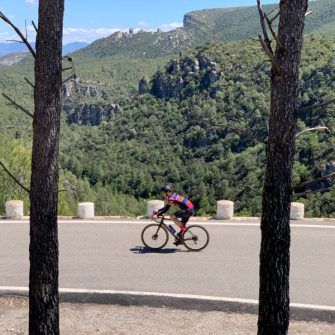 Cyclist in Spain’s Costa Daurada
Cyclist in Spain’s Costa Daurada Cycling Els Angels in Spain
Cycling Els Angels in SpainTo make planning for your Spain cycling holiday a little easier, we have split the country into five geographic regions. We start in the south and go anti-clockwise, up the east coast, along the north coast and then down to Madrid in the centre.
We’ll spend the remainder of this article giving you an overview of what each area is like. Further on you’ll also find links to our detailed guides on many of these regions.
South coast
Andalucía
South east coast
Calpe and Murcia
North east coast
Catalunya and the Spanish Pyrenees / Andorra
North coast
Aragon, Navarra, Basque region, Cantabria and Asturias
Central
Around Madrid
South coast of Spain
Andalucía is the largest region of southern Spain (and the second largest in the country). Cycling holidays in Andalucía are extremely popular.
The stunning Sierra Nevada mountain range and the area around the Tabernas desert provide some of the most challenging and scenic routes in Spain.
The smaller mountain ranges of the Sierra de Grazalema and Sierra Cazorla are also popular haunts and as you move further east you find the flatter lands of Murcia and the undulating terrain of Calpe.
The historic cities of Granada, Cordoba and Sevilla are all within reach for a day off the bike so that you can immerse yourself in the history and culture of this part of the world.
Sierra de Grazalema
Lying inland, and south east of Seville, the Sierra de Grazalema isn’t the most well-known cycling destination in Spain. However, if you are looking for somewhere quiet and surrounded by natural beauty, then this may be the place for you.
There are some long climbs and plenty of undulating terrain all set in what can be best described as typical rural Spain. The rolling landscape is punctuated with small, white-stoned villages (pueblos blancos) and acre upon acre of citrus and oak trees. These make for a very pleasant experience whether you are riding seriously or just ambling along for leisure.
Famous climbs
The most popular climb in the region is probably the Puerto de las Palomas, which is located near to the Embalse de Zahara – el Gastor (reservoir).
Places to stay
Ronda
 Ronda
Ronda Embalse de Zahara – el Gastor reservoir
Embalse de Zahara – el Gastor reservoirSierra Nevada
Moving east from the Sierra de Grazalema, is the Sierra Nevada National Park. It is the second highest mountain range in Europe after the Alps.
Located near to the city of Granada, the area is simply stunning; torrential rivers give way to sheer-sided gorges, scree slopes and glacial lakes. Whilst hundreds of thousands of acres of cultivated terraces of fruit and vegetables nestle below sun kissed and snow-capped peaks.
Famous climbs
The Sierra Nevada is home to the highest paved road in Europe, which peaks at a staggering 3,396 metres at the summit of Pico Veleta. However, many cyclists will find themselves having to turn around just after the barrier at 2,550 metres at Hoya de la Mora, as the final 13 kilometres are often under snow.
Don’t be surprised to see the World Tour professionals on these roads as many train and stay at the National Altitude Training and Performance Centre, the Centro de Alto Rendimiento (CAR), which is a couple of kilometres from the barrier at Hoya de la Mora in the ski village of Pradollano.
The climb to Hoya de la Mora (2,550 metres altitude) and on the southern side, the climb to the mountain village of Trevelez which sits at 1,500 metres, both make for amazing rides.
Places to stay
Granada, Monachil, Motril
More information
- Our guide to cycling the Sierra Nevada.
- Our guide to cycling Granada.
- Our article on cycling between Seville and Valencia via Granada.
Sponsor Message
Grab yourself a discount!
Check out the grey feature boxes (like this) in the articles below and find exclusive savings on cycling tours in Spain:
- Calpe, Spain (offer with Sierra Sports & Tours)
- Girona, Spain (offer with Sierra Sports & Tours)
- Granada, Spain (offer with Sierra Sports & Tours)
- Sierra Nevada, Spain (offer with Cycle Sierra Nevada)
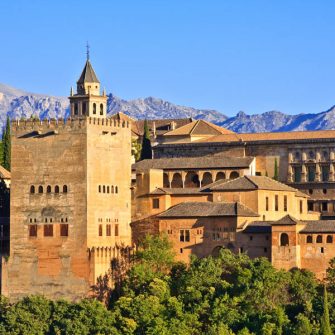 Granada
Granada Illar in La Alpujarra Granadina, Sierra Nevada
Illar in La Alpujarra Granadina, Sierra NevadaSierra de Cazorla
Further inland, north of the Sierra Nevada and to the west of the city of Jaen, lies the Sierra de Cazorla National Park. It is one of the biggest national parks in Europe. As a UNESCO world heritage site, it is a very popular destination for walking, camping, bird watching, climbing and cycling.
Famous climbs
This area is not as popular as many other Spanish cycling destinations but it’s almost traffic free in parts and provides some stern climbing tests, such as the Collado de la Traviesa and the Agua de los Perros.
Places to stay
Jaen
Sponsor Message
Grab yourself a discount!
Check out the grey feature boxes (like this) in the articles below and find exclusive savings on cycling tours in Spain:
- Calpe, Spain (offer with Sierra Sports & Tours)
- Girona, Spain (offer with Sierra Sports & Tours)
- Granada, Spain (offer with Sierra Sports & Tours)
- Sierra Nevada, Spain (offer with Cycle Sierra Nevada)
Tabernas Desert area
Heading back towards the coast, around 30 kilometres north of the coastal resort of Almeria lies the Tabernas desert which, as well as being famous as the setting for many Spaghetti western films, also lies close to two of the best climbs in the area.
Famous climbs
The Alto de Velefique, or the Spanish Alpe as it is known locally, is a stunning climb. It has no less than 20 switchbacks (one less than its French counterpart and is of a very similar distance and gradient).
Nearby the ascent to the giant observatories at Calar Alto is a monster of a climb of over 30 kilometres at around 7% gradient taking you to over 2,000 metres in elevation. Besides the giant Observatory buildings at the summit you can literally see for miles.
The nearby Sierra los Filabres mountain range provides many additional cycling routes including the lovely ascent of the Puerto de la Virgen near Cobdar. If you’re thinking of a cycling holiday in southern Spain in the winter then look no further.
Places to stay
Almeria
More information
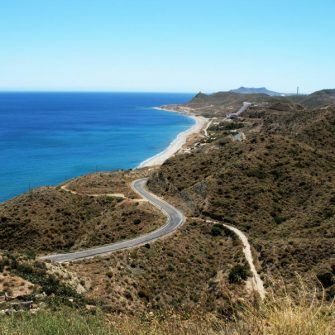 Stunning Almeria coastline
Stunning Almeria coastline Twists and turns of the Alto de Velefique
Twists and turns of the Alto de VelefiqueMójacar
An hour or so east of Tabernas (by car) and north of Almeria, lies the coastal town of Mójacar. The nearby holiday resort of Mójacar Playa has plentiful accommodation and beautiful golden beaches. This area has some of the best cycling in Spain, particularly if you are looking for winter cycling and you have a car so you can get out to the Tabernas Desert area too.
Home to the relatively new Gran Fondo Costa Almeria, this is the perfect location for those that want to mix cycling with sunbathing. In cycling terms this part of the world is something of a hidden gem with its super smooth roads, minimal traffic and gorgeous weather and scenery.
Famous climbs
You can ride along the coast towards Agua Amarga and enjoy the delights of the Parque Natural del Cabo de Gata-Nijar or head inland to test yourself on the climbs of the Sierra Bedar, El Chieve and the Puerto de la Virgen.
Places to stay
Mójacar Playa
More information
 Inland Almeria
Inland Almeria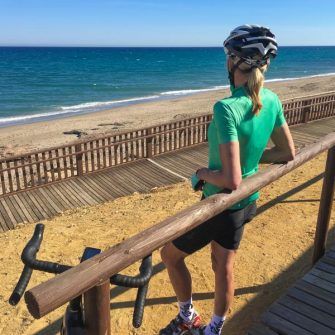 The beach at the coastal town of Mójacar Playa
The beach at the coastal town of Mójacar PlayaSouth east coast of Spain
Calpe
The town of Calpe, in the south east corner of Spain, is one of the most popular winter training destinations in Europe. Professional teams wanting to get in those early season miles and enthusiastic amateurs just wanting to pedal in the sunshine have been coming here for years.
Handily placed an hour’s drive from the airport at Alicante, cycling holidays in Calpe provide excellent value for money with plentiful accommodation at reasonable prices during the autumn and winter months.
The area has some mid-range mountains and plenty of undulating terrain on quiet roads with good surfaces.
Throw in year round sunshine, some beautiful beaches and a flourishing cycling culture and you can see why the area is so popular; combine a break in the sun with a Costa Blanca cycling holiday!
Famous climbs
The Vuelta a España visits the area quite frequently, with the ascents of Cumbre del Sol, Coll de Rates, Vall d’Ebo, Alto de Confrides and the Puerto de Tudons all being popular haunts for the climbers.
Places to stay
Calpe, Denia
More information
 Vall d’Ebo near Calpe
Vall d’Ebo near Calpe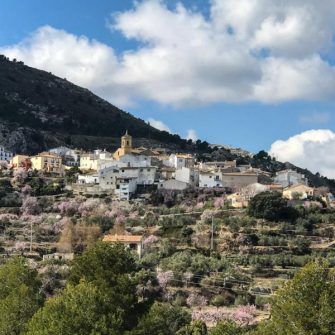 Around Guadelest, Costa Blanca
Around Guadelest, Costa BlancaMurcia
The province of Murcia gets an impressive 320+ days of sunshine each year and has a reputation for being one of the warmest areas of Spain. Boosted by this and the opening of a new international airport, the area is slowly becoming a magnet for those who want to cycle in the sun but who also want to get away from the crowds.
Home to the Spanish icon Alejandro Valverde, Murcia is relatively flat. However there are also a number of climbs such as the stunningly beautiful Sierra Espuna (set in a national park), the Cresta del Gallo and Cabezo de la Plata which will all test the legs.
There is plenty of accommodation available on the coast, particularly in the town of Los Alcazares, which sits by the huge Mar Menor lagoon. The nearby 5 star resort at La Manga Club is close to the historic port city of Cartagena and is also popular.
So if you want to get away from it all, cycle on good quality roads in glorious weather and prefer relatively flat terrain, then take a close look at Murcia.
Places to stay
Los Alcazares, La Manga Club
More information
- Our article on cycling in Murcia
 Top of El Morron cycling climb, Murcia
Top of El Morron cycling climb, Murcia Quiet roads and beautiful road surfaces
Quiet roads and beautiful road surfaces
North east coast of Spain
Girona and the Costa Brava
Some would argue that Girona is the cycling capital of Europe – although Majorcan cycling fans would perhaps disagree!
What can’t be disputed is that so many professional cyclists choose this area as their home. Indeed some World Tour teams have their service courses based in the city.
If you go out for a couple of hours in Girona and don’t see a professional cyclist or two training on the local roads, it’s unusual. Not surprising then that Girona cycling holidays are so popular!
The climate in this part of the world is perfect for cycling between March and November but like most parts of Spain in the summer months it can be really hot. Fortunately the quaint fishing villages along the nearby Costa Brava coastline can provide respite.
Famous climbs
The terrain is generally flat around the city with the exception of the famous Els Angels climb, which from the monastery at the summit, affords terrific views of both the city and the distant Pyrenean mountain range.
Further afield are the tougher ascents of Mare de Deu del Mont and the world renowned climb of Rocacorba.
To the north west of the city lies the Garrotxa National Park and the foothills of the Pyrenean chain. There are some wonderful opportunities here to ride on almost deserted roads amongst beautiful verdant meadows and woodland in what is best described as rural Spain.
If it’s mountains you want to climb, then the ascent to Vallter ski station takes you to more than 2,000 metres whilst the sinuous Coll de la Creueta, near the beautiful town of Ripoll, peaks at 1,925 metres. A hidden gem is the climb to the Santuari del Far near the town of Olot which at the top provides a view that simply has to be witnessed to properly appreciate.
Further north and west and about an hour or so’s drive from the Coll de la Creueta, is the small principality of Andorra which sits in the middle of the Pyrenees mountain range and has a land border with both France and Spain.
In recent years due to the advantageous taxation laws, the superb quality of the roads and the multitude of long mountain climbs many professional cyclists have chosen the area as their home.
The climb to the summit of the Port d’Envalira which has been used in both the Tour de France and the Vuelta a España tops out at 2,407 metres. There are a handful of other peaks that go over 2,000 metres, so this is an ideal place to come for altitude training.
Places to stay
Girona region
More information
- Guide to cycling in and around Girona
- Bike tours in/around Girona
- Cycling camps in Girona
- Gravel cycling in Girona
- Interview with local cyclist Adria Moreno
 Garrotxa region, near Girona
Garrotxa region, near Girona Mare De Déu Del Mont Girona, Costa Brava
Mare De Déu Del Mont Girona, Costa BravaCosta Daurada
The resorts of Salou and Cambrils sit on the Costa Daurada, a strip of Mediterranean coastline and quiet inland hills, medieval villages and vineyards, between Barcelona and Tarragona.
The area is relatively new to the cycling scene but working hard to build a reputation. Primarily an area popular with family holidays, it has a lot going for it when you consider the easy access from the airport at Barcelona. You’ll find golden sandy beaches, quiet roads and of course sunshine.
A couple of World Tour teams have used the area as a training base in recent years and, whilst it doesn’t have the cachet of Girona, it is undoubtedly an option to consider.
The nearby cities of Tarragona, and of course Barcelona, are an added benefit providing plenty to do and a wealth of facilities when off the bike.
Famous climbs
The terrain is relatively flat and ideal for those pre-season base miles or for groups with mixed cycling abilities. There is no shortage of climbs in the nearby Serra de Llaberia, Serra de Montsant and Muntanyes de Prades areas.
Places to stay
Cambrils, Salou
More information
- Our guide to cycling in the Costa Daurada.
- If Costa Daurada is of interest, you should also read about Catalonia’s Terres de l’Ebre region, just to the south of Costa Daurada. It’s even less known by cyclists than Costa Daurada, but it’s incredibly beautiful.
 Climbing Ventoses on the Costa Daurada
Climbing Ventoses on the Costa Daurada Descending down towards Capafonts
Descending down towards Capafonts
North coast of Spain
This part of Spain is very mountainous and these mountains are the main reason why the Vuelta a España visits each year.
The coastal regions experience a fair amount of wind and rain, particularly in the winter months, which leads many to refer to this area as ‘Green Spain’.
Galicia, Asturias, Cantabria and Pais Vasco (Basque Country)
There are four regions running along the northern coastline of Spain namely Galicia, Asturias, Cantabria and Pais Vasco (Basque Country).
West of Bilbao, in the Asturias and Cantabria regions, lies the Picos de Europa National Park. It’s not nearly as well known as the Alps and Pyrenees but it’s hugely beautiful and is known as being quiet from a traffic perspective. You’ll find limestone mountains, deep gorges, ancient forests and traditional villages. The area is also famous for its caves where the remains of ancient man have been discovered.
Famous climbs
The climbs in this part of the world tend to be of medium length but savagely steep and can even test the ability of the very best professionals.
It’s here you can find the classic ascent of the Lagos de Covadonga, which regularly features in the Vuelta.
The iconic climb of Alto de l’Angliru (Asturias) and Alto de los Machucos (Cantabria) have both become legendary within cycling circles due to their brutal 20% plus inclines.
There are too many famous climbs in this part of the world to mention, but the ascents of Fuente Dé and Pena Cabarga (Cantabria), La Farrapona and Puerto de Somiedo (Asturias), Puerto de Ancares (Galicia) and the Monte Oiz, Arrate and Jaizkibel in the Basque region are all worth checking out.
Places to stay
San Sebastian, Bilbao, Oviedo
More information
- Our guide to cycling northern Spain
- Article on the Camino de Santiago
- Camino FAQs.
 View over the Basque country
View over the Basque country Down over the harbour at San Sebastian
Down over the harbour at San SebastianNavarra and Aragon
Further to the east and bordering France are the provinces of Navarra and Aragon.
Navarra is a cycling hotbed with Movistar having their service course in the region. Navarra’s most famous son is the legendary Miguel Indurain.
Sitting right up against the southern flank of the Pyrenees is Aragon and, as you would imagine, there are some long mountain climbs in the area.
The Quebrantahuesos Gran Fondo is one of most famous Spanish biking events in the Spanish cycling calendar. It’s based in this part of the world and incorporates the climbs of the Portalet and Somport during its 200 kilometre circular loop.
Running along some of the northern provinces are the Camino Santiago routes created and made famous by pilgrim travellers in the 12th century. There remain many routes suitable for both walking and cycling including the famous Camino Frances.
Starting in St Jean Pied de Port just over the border in southern France the route heads south into Spain and passes through the cities of Pamplona, Burgos and Leon until it concludes, after 790 kilometres, in Santiago in the north western province of Galicia.
Famous climbs
Arguably the most well-known climb in the area is the ascent to Port Larrau.
Places to stay
Pamplona, Jaca and Ainsa
 Castle in Aragon, Spain
Castle in Aragon, Spain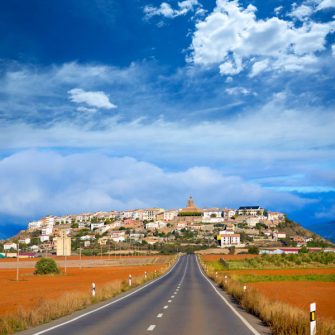 Berdun in Huesca Aragon Pyrenees
Berdun in Huesca Aragon Pyrenees
Central Spain
Madrid area
Travel 100 kilometres north from Spain’s capital and you will find the Sierra de Guadamarra mountain range, which is a very popular haunt for cycling Madrileños.
The Vuelta a Espana during its last week, en route to the finish in Madrid, often spends a couple of days in the area which straddles both the community regions of Madrid and Castilla y Leon.
Famous climbs
The mountain passes of Navacerrada, Morcuera and Canencia rise to between 1,500 – 1,900 metres in altitude all providing stern tests.
If you fancy something really high the Bola del Mundo climb near Collado Villalba tops out at 2,257 metres.
Places to stay
Northern outskirts of Madrid
Spain’s islands
This article focuses on cycling in mainland Spain. For guides to some of Spain’s best islands for cyclists, check out our Spain hub page – or go direct to our guides on Lanzarote, Tenerife, Gran Canaria and Mallorca.
Sponsor Message
Grab yourself a discount!
Check out the grey feature boxes (like this) in the articles below and find exclusive savings on cycling tours in Spain:
- Calpe, Spain (offer with Sierra Sports & Tours)
- Girona, Spain (offer with Sierra Sports & Tours)
- Granada, Spain (offer with Sierra Sports & Tours)
- Sierra Nevada, Spain (offer with Cycle Sierra Nevada)
Conclusion
Spain is a huge country and the opportunities for road cyclists are extensive and varied.
We hope this article has given you a useful overview of some of the different areas that might offer what you’re looking for in your next Spain cycling holiday.
Before you go, make sure you read our personal favourite cycling destinations in Spain, our tips for picking a cycling holiday in Spain (including how to choose between self-guided cycling tours and guided cycling tours) and our comparison of cycling tours in Spain (both self-guided cycling holidays and guided options).
Also consider our tips for cycle route planning and these tips for cycling in Spain may also be useful:
- It is advisable to carefully check in advance the route for cafes, restaurants and petrol stations. It is not uncommon when riding in some areas to go a couple of hours without seeing anywhere that sells food or drink, sometimes you won’t see a car for an hour!
- As you can sometimes be cycling in remote and extremely hot conditions you need to have a sound refuelling strategy in place before you set off.
- Similarly in some rural and mountainous areas there is a distinct lack of good accommodation. You may need to stay in a hotel several kilometres away from your preferred riding area and travel by car to a given point.
For more information on Spain road cycling in Spain and planning a Spain cycling tour, check out our Spain hub page here. You can also get more inspiration from our long distance cycling routes in Spain article here.
All our guides to cycling the different regions of Spain including cycling route information, tips for bike hire and the best cycling season to visit in.
Please support Epic Road Rides
A huge amount of time and effort goes into the article you’ve just read, all with the aim of helping you!
If you found what you’ve read useful, I’d really appreciate it if you dropped something in the tip jar here.
It’s a way you can say thank you and help us carry on creating top quality content with no annoying ads and no pay wall.
Looking for an organised cycling trip?
If you want someone to help you plan and book your cycling holiday, fill out this form. We aren’t a tour operator/agent but we work with lots of people who are and will do our best to put you in touch with someone that can help (within 24 hours where possible)!This article includes details of products and/or services that we have used ourselves or which we would consider using. Some are paid features or include affiliate links or referral codes which we may earn commission from. As an Amazon Associate we earn from qualifying purchases. Please read our disclosure policy for further information.
The contents of this website are provided for general information purposes only. It is not intended to amount to advice and you should not rely on it. You should carry out your own due diligence and risk assessments and take professional advice. Views expressed by interviewees or other users of this website do not necessarily represent our views. We make no representations, warranties or guarantees, whether express or implied, that the content on our website is accurate, complete or up to date. If you use any information or content on this website, download from, or otherwise obtain content or services through our website, it is entirely at your own discretion and risk. Epic Road Rides Ltd disclaims all liability and responsibility arising from any reliance placed on the information and content on this website. Find out more here.


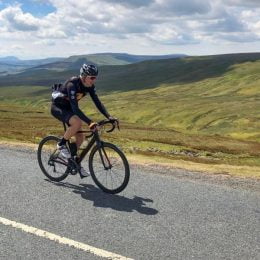
Comments